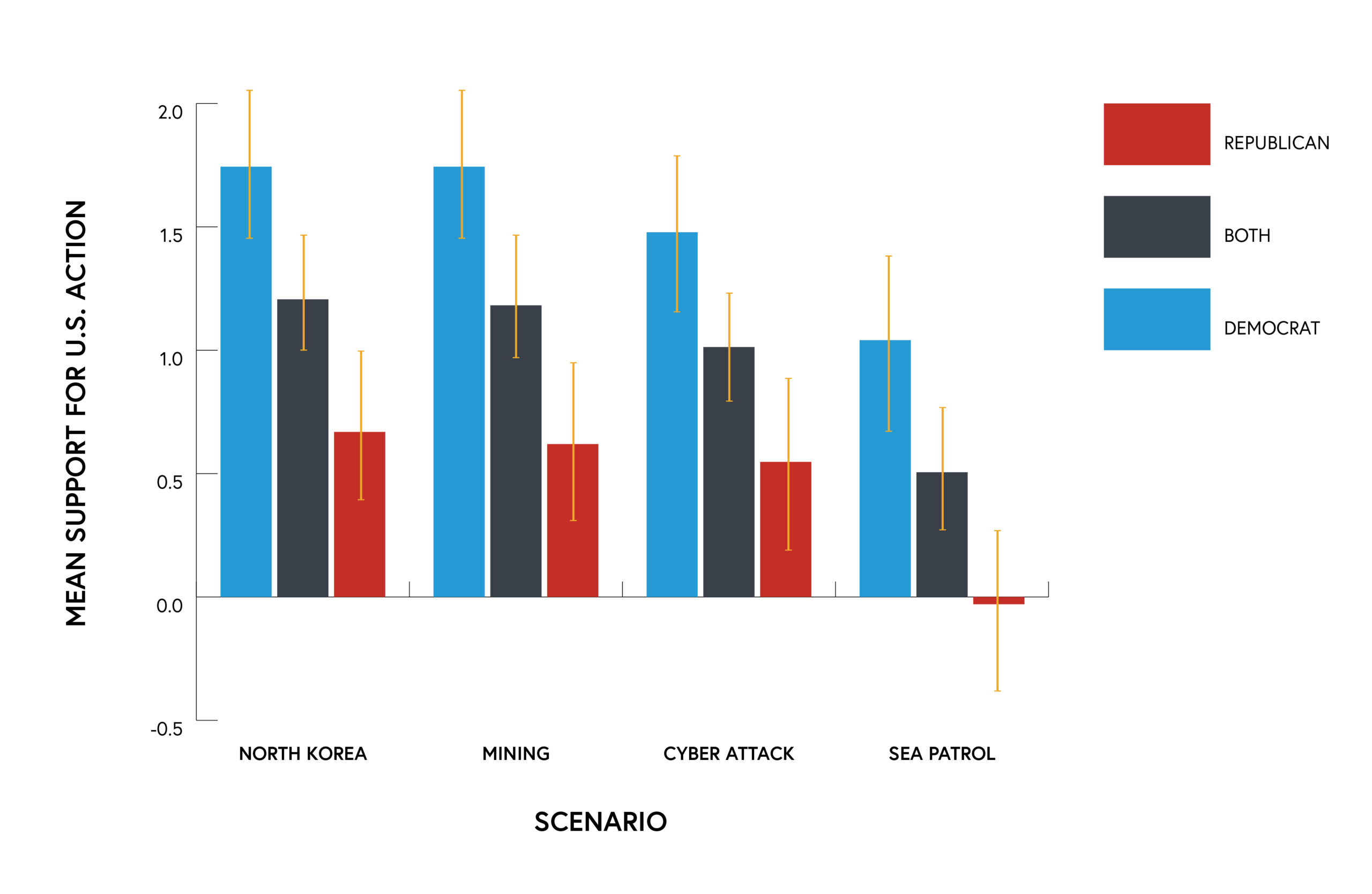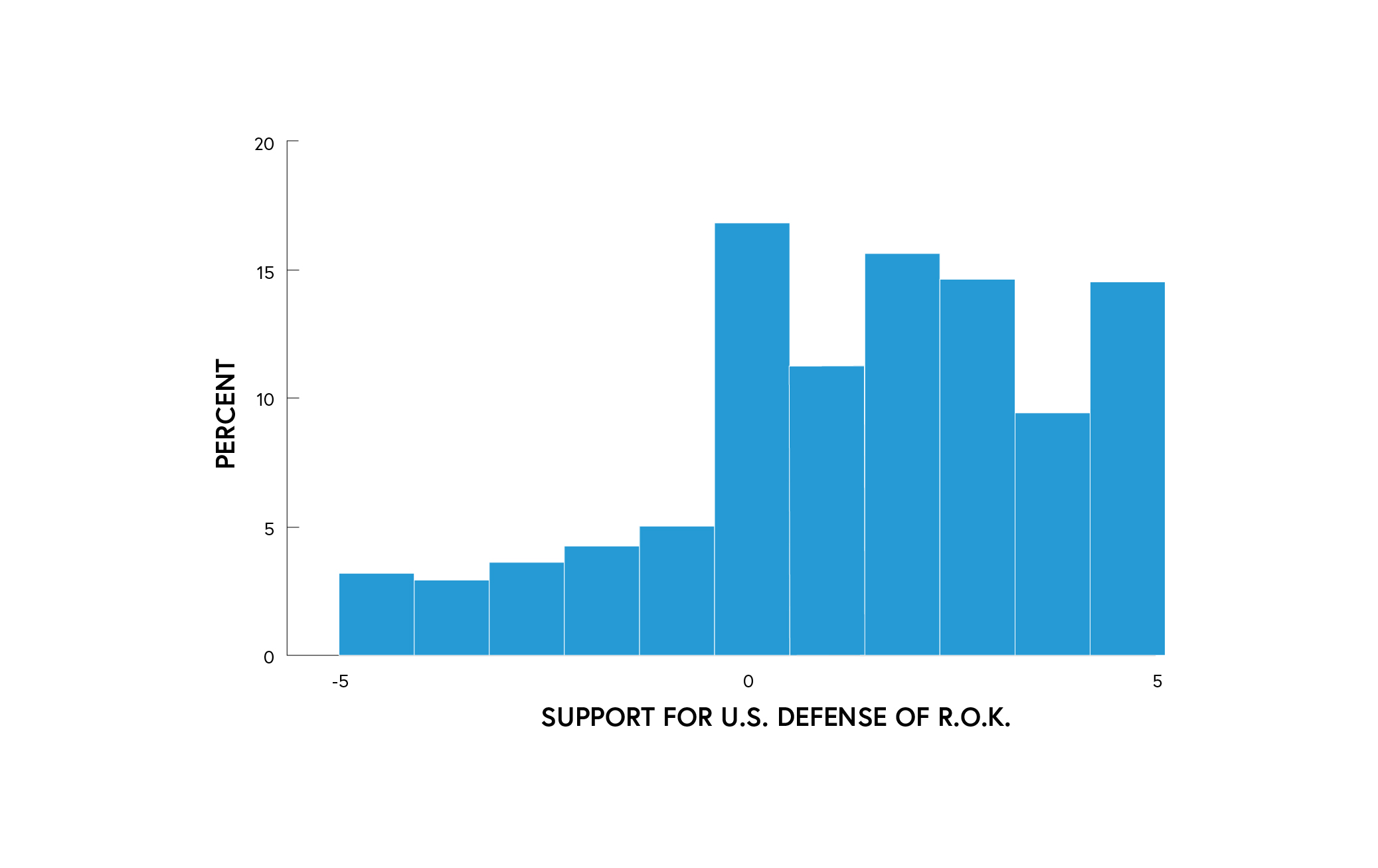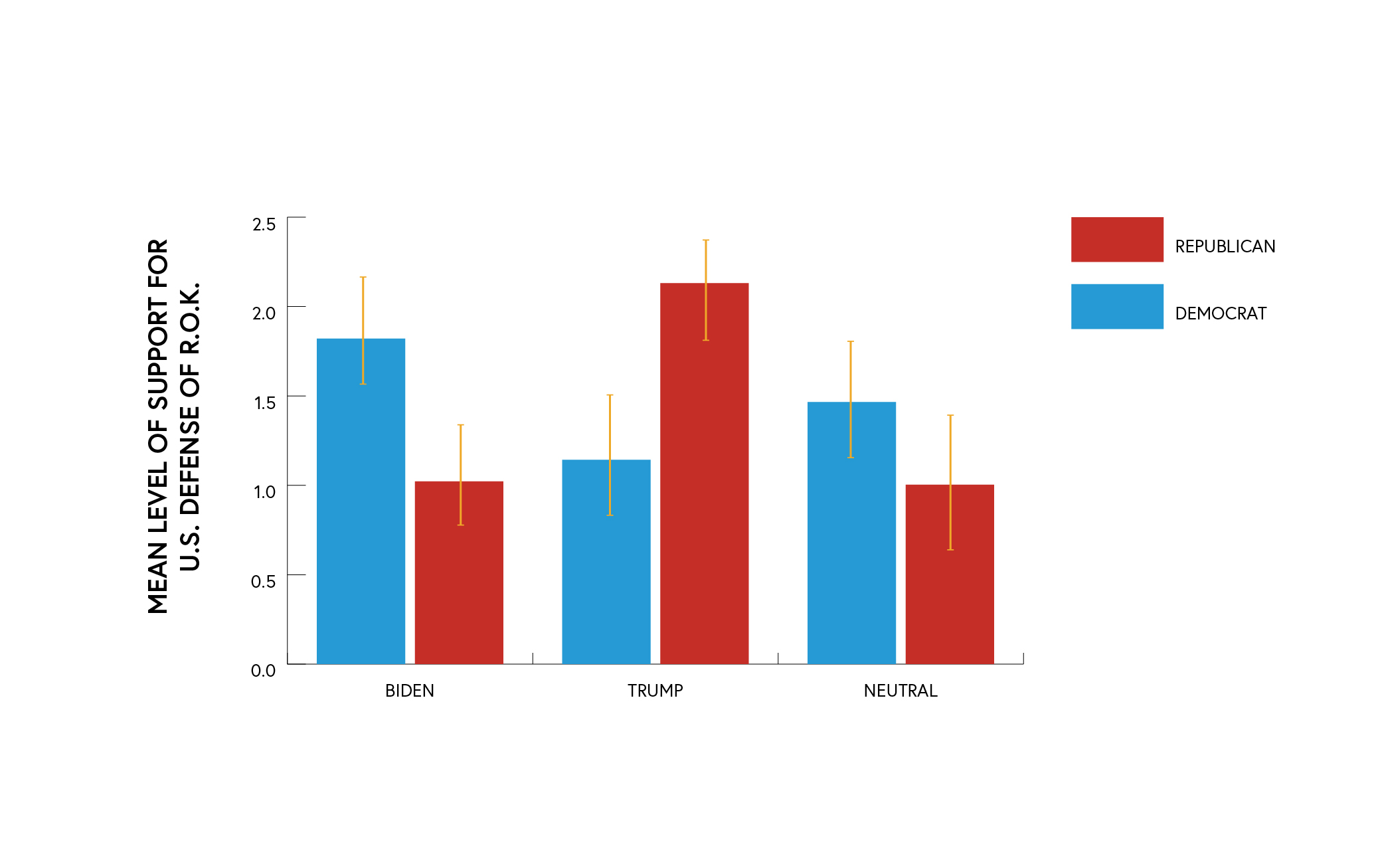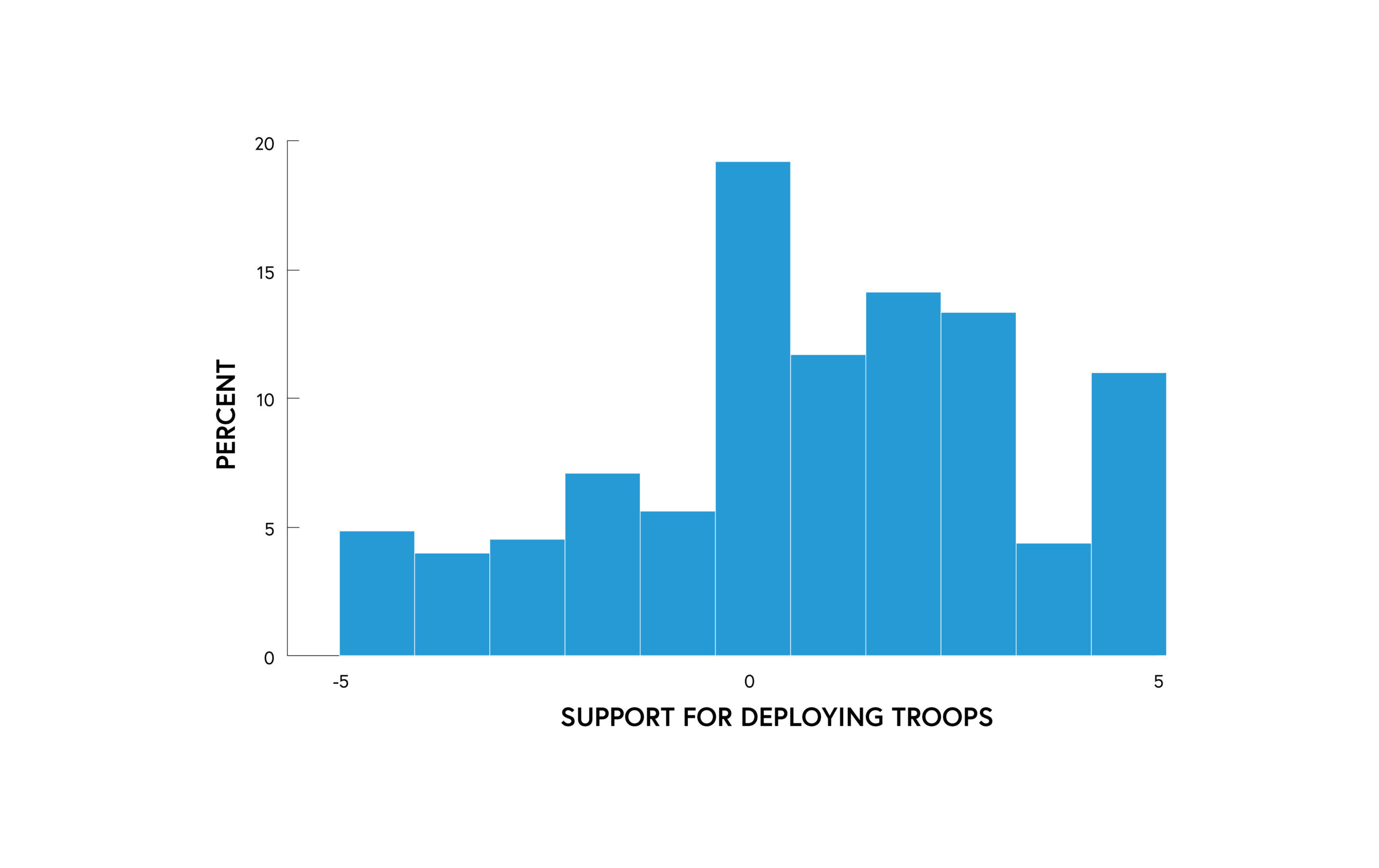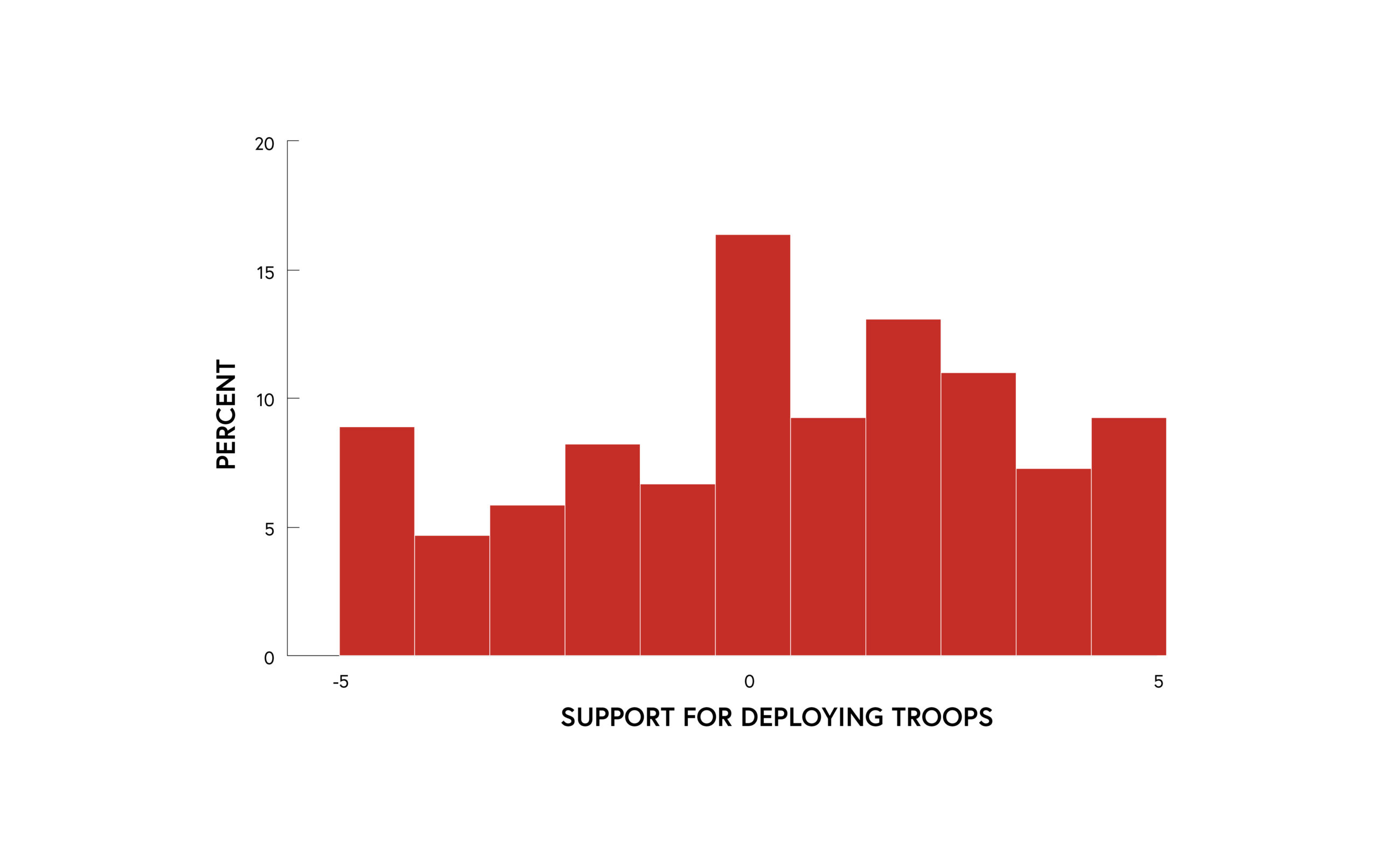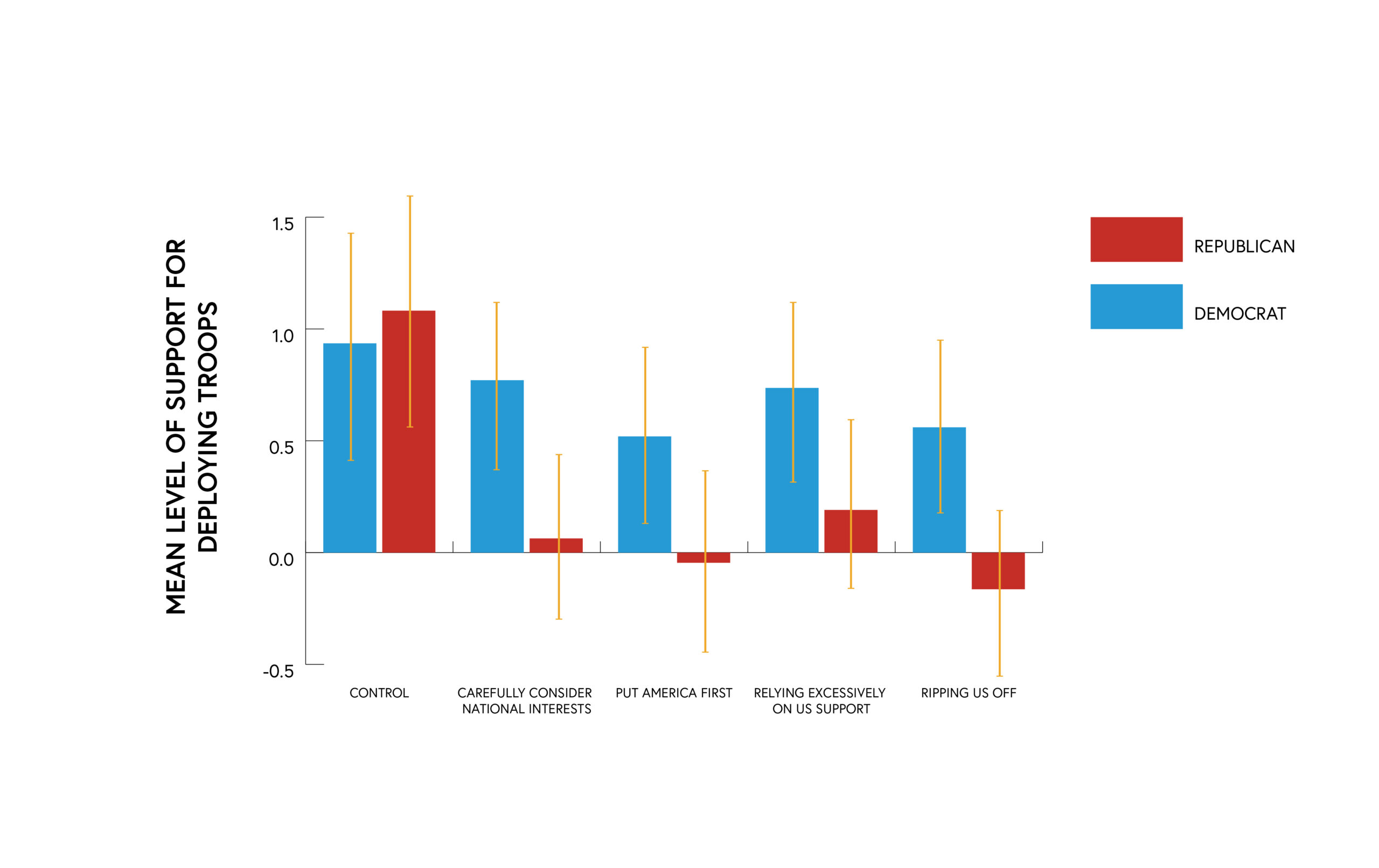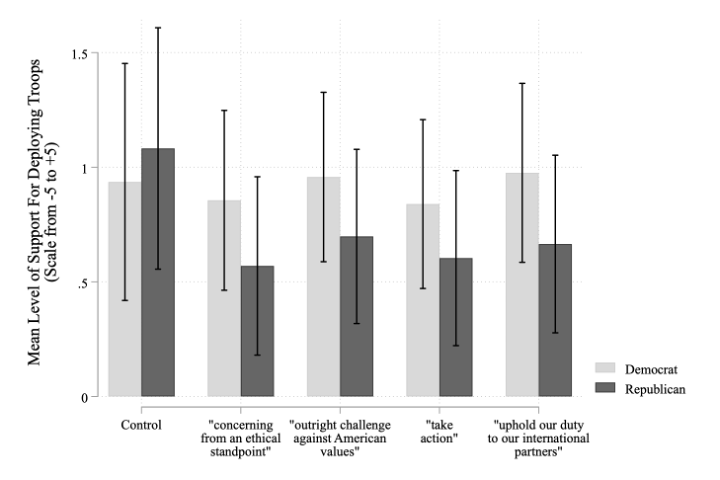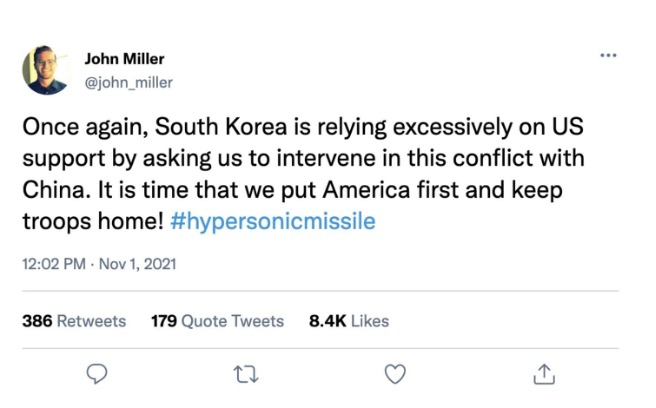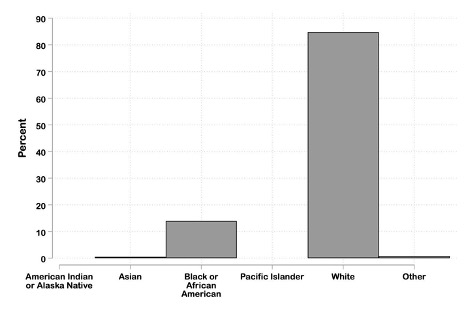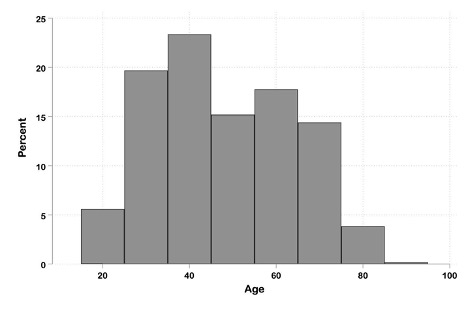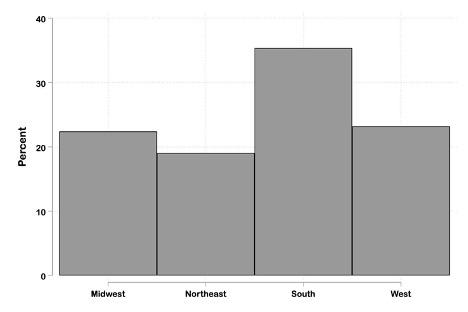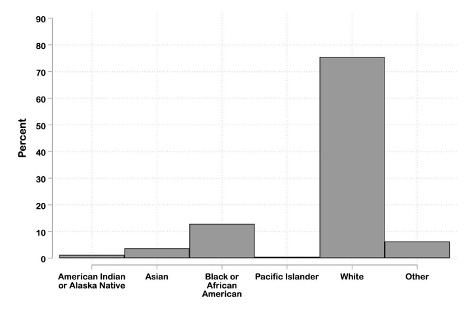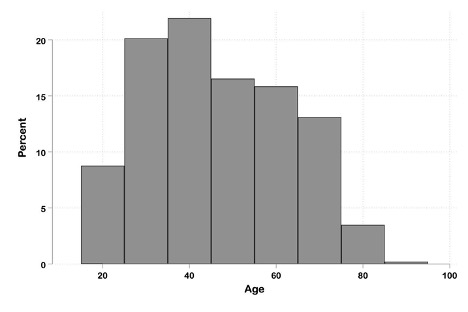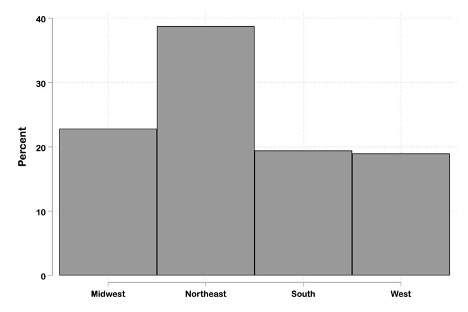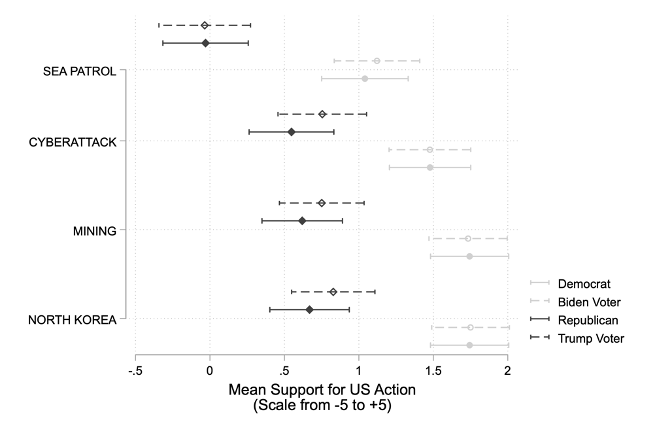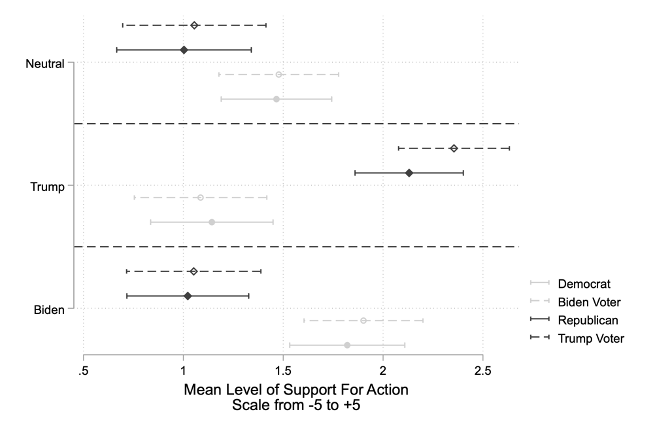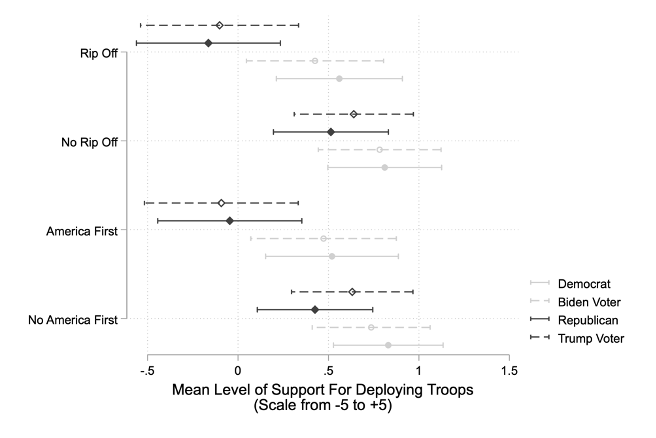A perennial question is whether countries will honor their alliance commitments. For decades, a degree of bipartisan consensus around foreign policy contributed to the perception that the United States would be willing to use force to live up to its specific treaty obligations.1 Domestic politics was said to end at the water’s edge. When Donald Trump ran for and secured the presidency on an explicitly nationalist “America First” platform, he openly questioned the alliance status quo. He chided allies for not doing enough to share the financial burden; he hinted at withdrawing U.S. troops from the territory of some allies (e.g., South Korea); he levied tariffs on allies; and his administration signed an agreement to move troops from Germany to Poland.2
The reality is that alliances are never ironclad. Commitment is always contingent. States cannot be forced to honor their treaty obligations, and in some cases, they do not live up to their treaty duties. Indeed, although defensive alliances are more often reliable than not, they are not honored about 25 percent of the time.3 Furthermore, alliance treaties also leave signatories with some discretion. Allies retain some ability to determine when they are obliged to aid an ally with force and what the nature of the response will be.4 There are other ambiguities too, such as whether cyber attacks should be regarded as an armed attack or the precise territorial boundaries covered by an alliance.5
Alliances thus face significant credibility challenges since they are, by nature, self-enforcing agreements.6 Yet, credibility is paramount for deterrence and extended deterrence,7 reputation,8 crisis bargaining,9 and maintaining alliance relations.10 Consequently, countries rely on measures to signal their commitment. To enhance the credibility of these signals, they attempt to raise the domestic costs of defection through hand-tying.11 Governments sign alliances and make bold pronouncements of support for an ally to raise the domestic political costs of backing down — what’s known as “audience costs” — thereby signaling their resolve to a possible adversary as well as their alliance partner.12 They also make costly investments — “sunk costs” — to signal their commitment by deploying troops on an ally’s soil, creating tripwires, building military interdependence, and taking other measures.13
Still, alliance commitment ultimately rests on domestic politics, and even such commitment measures can never be locked in indefinitely. As Paul Musgrave observes, in democracies, electoral politics create incentives over the long term for politicians to change the status quo as parties seek to differentiate themselves when coalitions shift. This dynamic has given rise to polarization that has eroded the democratic base of support for U.S. hegemony.14 While Musgrave uses historical examples, the United States is currently experiencing intense partisanship reflected in changing foreign policy views on issues such as trade and, more recently, support for Ukraine.15 This may also have important implications for the domestic political durability of alliance commitment.
This paper studies the effects of partisanship on U.S. voter commitment to allies, specifically the Republic of Korea, under conditions of partisan polarization. To examine this, we administered surveys to U.S. voters in January of 2022 and March of 2023, wherein we experimentally analyzed the impact of various partisan cues on their support for South Korea. We found that, while overall support for defending South Korea is relatively stable across a range of different hypothetical scenarios, there are underlying differences between Democrats and Republicans. Democrats show higher support than Republicans for aiding and defending South Korea. Moreover, presenting more overt partisan cues that appeal to an individual’s partisan group identity can have substantial impacts on levels of support for South Korea. Voters, particularly Republicans, are responsive to partisan leadership cues and strong language that echoes Trump’s America First rhetoric. However, appeals to duty and values in support of maintaining alliance commitments have little effect on voters, Democrat or Republican. These results suggest that polarizing messaging can subvert public support for allies. One implication is that leaders may be able to influence voters in ways that reduce the potential domestic costs of reneging on alliance commitments, which has the potential to undermine alliance credibility.
The following section elaborates how partisan polarization has the potential to weaken voter commitment to allies. We then introduce our research approach, followed by a presentation of our survey experiments and results. Finally, we conclude with a discussion of the implications of our findings for the U.S.-South Korean alliance and alliance commitment more broadly, some of the limitations of our study, and areas for future research.
Partisan Polarization and Alliances
Before looking at the results of our survey, it is important to understand the implications of partisan polarization for alliances. We define partisan polarization as the growing division of people’s opinions and identities along partisan lines. Below, we focus on two broad types of polarization: ideological polarization and group identity polarization.
Ideological Polarization
Ideological polarization refers to the growing divergence of public beliefs among voters and their sorting into two increasingly distinct political parties. Research points to growing ideological polarization across a range of policy issues, such as the economy, civil rights, and foreign policy.16
There are several ways in which the ideological polarization of voters matters for alliance commitment. First, some research suggests that voters are aware of foreign policy issues and that foreign policy can influence their vote.17 Thus, voters may play a role in electing — or creating the possibility of electing — candidates who are skeptical of international commitments and less supportive of aiding and defending allies. Second, ideological polarization may influence alliance support directly via public opinion. Public opinion has been found to influence politicians and military leaders in making critical decisions about using force or maintaining military activities.18 Third, ideological polarization could reduce domestic political costs for reneging or weakening commitment mechanisms. With greater ideological polarization, leaders may rely increasingly on a political base of strong partisan supporters. A growing number of alliance skeptics within a party would give a leader greater room to maneuver and perhaps even incentives to weaken alliance commitments. Leaders would thus face few domestic political repercussions among supporters were they to undo earlier commitments, such as to deploy troops on an alliance partner’s soil, or possibly even were they to choose not to live up to their treaty obligation to defend their ally.
These polls suggest that there may be an emerging skepticism of alliances among Republicans relative to Democrats.
Voters may indeed be developing increasingly distinct ideological preferences toward alliances that split along party lines. Opinion polls show growing divergence in foreign policy beliefs generally and for alliances specifically. According to the Pew Research Center, among Republicans or those that lean Republican, support for an active U.S. role in the world has declined from 53 percent in 2004 to only 45 percent in 2019. By contrast, support among Democrats increased from 37 percent in 2004 to 62 percent by 2019. The Pew Research Center also finds a large and growing partisan gap in expectations for U.S. allies. In 2019, only 31 percent of Republicans or those leaning Republican believed that the United States should compromise with allies by taking their interests into consideration, compared to 42 percent in 2004. By contrast, 83 percent of Democrats or those leaning Democrat supported that view, up from 65 percent in 2004.19 Another poll from Reuters / Ipsos in 2018 found that two-thirds of Republicans agreed that America should not be bound by treaty commitments if NATO allies do not spend sufficiently on defense, whereas about 40 percent of Democrats held the same view.20 These polls suggest that there may be an emerging skepticism of alliances among Republicans relative to Democrats.
Group Identity Polarization
Another perspective on polarization suggests that people sort by social identity rather than ideology.21 Increasingly, party identification has become more central to people’s identity rather than reflective of a specific set of ideological beliefs. Indeed, some research finds that one’s identity as a member of a political party is even stronger than religious, linguistic, ethnic, or regional identities.22 Furthermore, the intensity of these partisan identities and the gap between them has been shown to be growing over time.23 This has driven partisan polarization by creating increasingly divergent social realities. From this perspective, partisan polarization is not so much about ideological divergence. Rather, partisan identity creates differences in perception of basic facts, the interpretation of facts, what facts are remembered, and the types of information that people seek.24
Voters’ views are driven by partisan cues, motivated biases, and emotions, rather than coherent ideological positions. Existing research suggests that voters take cues from party leaders and elites and align their views accordingly.25 In a polarized world, the effect of party endorsements on public opinions increases, voter receptiveness to substantive information declines, and voters become more confident in their own opinions.26 Moreover, the fragmented media and social media landscape facilitate self-confirming information seeking,27 and partisans select increasingly distinct media sources that reinforce their preexisting views. Emotion also drives partisan identities, and leaders use charged rhetoric to connect with co-partisans and accentuate differences with members of the other party. Such affective polarization has led partisans to view members of the outgroup with increasing suspicion, hostility, and even hatred.28
From the perspective of group identity polarization, leaders may be able influence the level of voter support for alliances through their rhetoric. Trump openly questioned the value of alliances and used angry rhetoric to suggest that allies were ripping off the United States. He sought to increase South Korea’s contribution toward the cost of maintaining U.S. troops in South Korea from $900 million to $5 billion.29 Moreover, he suggested at times that the United States should undo one of its key commitment mechanisms by removing U.S. troops from South Korean soil.30 Co-partisans may be influenced by such messages from a leader, which may be reinforced through selective consumption of news and social media, emotional appeals by the president or other leaders, and other types of motivated reasoning.31 If voter views are, in fact, highly malleable, as Matthew Baum and Philip Potter suggest, then the dynamics of costly signaling may be undermined, which could weaken the credibility of America’s commitment to defend South Korea.32 A leader such as Trump may have the means to limit domestic audience costs by swaying supporter opinions and could therefore undo commitment mechanisms, such as drawing down or eliminating America’s troop presence, with little domestic political consequence.
Some evidence suggests that group identity polarization may have different effects on Democrats and Republicans. Some research has found that Republicans are more prone to feelings of outrage.33 Moreover, partisan sorting has created greater social cohesion in the Republican party as it has become whiter and more Christian, while Democrats have become a broader and more diverse coalition.34 With less heterogeneity and greater tendency to feelings of outrage, polarizing cues may have clearer and stronger effects for Republicans than for Democrats.
Existing Work
While there is some existing work that is relevant to understanding the effects of partisanship on support for alliances, the evidence is mixed. One study suggests that there is no partisan divide between Democrats and Republicans toward alliances.35 Other research finds that audience costs do not vary by partisanship in situations that involve a leader backing down from a public statement to defend another country (not necessarily an ally) that has been invaded.36 Michael Tomz and Jessica Weeks reach a similar conclusion with regard to formal alliances. They found that alliance treaties increase audience costs and that these effects hold regardless of partisan affiliation.37 Joshua Alley, however, notes systematic differences between strong partisans, specifically Democrats who are committed to alliances and Republicans who are skeptical of alliances. Moreover, these strong partisans are not responsive to elite cues.38 Kyung Suk Lee and Kirby Goidel investigated whether different framings and partisan cues affect U.S. voter support for NATO. They found that framing the alliance in terms of cost to the United States reduces support for NATO, but that a cue from Trump had a weaker and more mixed effect.39 This study seeks to contribute to this work by systematically examining the effects of ideological and group identity polarization using four survey experiments.
Research Approach
Case Selection
While there is debate about the use of hypothetical versus real world cases, we have chosen to focus on U.S. voter views toward South Korea.40 Compared to hypothetical scenarios that do not use actual countries, using the U.S.-South Korean alliance allows us to present more realistic scenarios to participants.41 At a minimum, there is likely to be higher validity because it pertains to an alliance that is important in its own right, and possibly more broadly to other similarly situated alliances such as the U.S.-Japanese alliance.
We used four survey experiments to test for partisan effects consistent with ideological and group identity polarization effects.
The United States and South Korea have had a formal military alliance since 1954, after an armistice was signed halting the Korean War. But even since America’s entry into the war in 1950, domestic politics have played a key role in U.S. policy toward South Korea. America’s involvement in the war was subject to domestic partisan politics with objections over the cost of the war, America’s strategy, the sacking of Gen. Douglas MacArthur, and other issues.42 In the late 1970s, President Jimmy Carter’s announcement of the withdrawal of all U.S. troops from the Korean Peninsula led to a political backlash from the armed forces as well as congressional leaders from both parties, which ultimately curtailed the drawdown of troops. Furthermore, in response to Carter’s intention to remove U.S. troops, Congress also authorized an aid package to strengthen South Korea’s military.43 More recently, Trump revisited the issue of support for South Korea. He openly questioned the need for U.S. military troops in South Korea and reportedly intended to remove them.44 He also made demands for much higher financial contributions to host the U.S. military in South Korea.
Empirical Strategy
We used four survey experiments to test for partisan effects consistent with ideological and group identity polarization effects. For the experiments, we presented our surveys to two separate pools — one made up of Democrats and the other of Republicans — of roughly the same size to focus on the effects of partisanship. The samples were balanced to be representative of U.S. census demographics in terms of age, race, and region. In addition, the samples were approximately representative in terms of household income.45 This block randomization approach enabled us to examine treatment effects more efficiently along partisan lines.46 The first experiment that we present below tests to see if there are underlying ideological differences between parties. The following three experiments prime respondents using treatments that target partisan group identities, including leadership cues, media cues, negative language cues, and positive language cues. It should be noted that we do not directly test the effect of partisan polarization or address whether it is increasing or not. Rather, our approach seeks to test for partisan effects that we would expect given the well-documented conditions of growing ideological and group identity partisan polarization.
The four experiments were fielded in two distinct online surveys of American voters. The first survey included the group identity polarization experiments and consisted of 1,896 respondents who took the survey between December 2021 and January 2022. The second included the ideological polarization experiment and consisted of 625 respondents who took the survey in March 2023. Both surveys were fielded with Lucid, a digital marketplace specialized in recruiting representative, high-quality survey takers.
We measure participants’ commitment to alliances in two ways: 1) as the degree of support to directly aid or defend South Korea across different situations; and 2) the level of support for a key commitment and reassurance mechanism in a crisis situation: the deployment of troops on South Korean soil.
Ideological Polarization Experiment
As discussed above, there is some evidence to suggest that Republicans may be more skeptical of alliances than Democrats. To test if there are any underlying policy differences between Republicans and Democrats when it comes to alliance commitment, we use a vignette survey experiment that was fielded from March 7, 2023 to March 14, 2023. After giving their consent to participate in the survey, respondents were provided with this brief description of our survey:
An on-going question in U.S. foreign policy is when to provide types of support to countries. We’d like to ask you a few questions about this subject. In the sections that follow, you’ll be presented first with some background about the topic. After reading the background, you will then be asked to consider situations that are hypothetical but realistic scenarios.
Respondents then read the following text:
In the sections that follow, you’ll be asked some questions about South Korea. For your convenience, we’ve put together some information about South Korea that may be relevant. Please read the following information carefully before proceeding to the next step.
We then provided a neutral presentation of South Korea that avoids overt partisan cues. The description of South Korea is composed from the six conditions listed in Table 1. To make it easier for respondents to retain the information that they read, we limited the information we presented to only three of the conditions and listed them as bullet points. The specific combination of three bullet points each respondent read was randomly assigned.
Table 1: Ideological Polarization Treatment Conditions
| Ally | In 1953, the United States and South Korea signed a formal military alliance, which remains in effect to this day, that declares “publicly and formally their common determination to defend themselves against external armed attack.” |
| Cost | The United States spends upwards of $3 billion annually to maintain its military presence in South Korea. |
| Common Interest | The largest military and economic threats to South Korea are its neighbors, North Korea and China, which many experts believe pose significant threats to the United States as well. |
| Establishment | South Korea, formally known as the Republic of Korea, was established in 1948 after World War II. |
| Population | South Korea has a population of 51.74 million, ranking as the 13th largest Asian country. |
| GDP | South Korea has a Gross Domestic Product (GDP) of 1.8 trillion U.S. dollars, a little under one tenth of the GDP of the United States. |
The first three facts in Table 1 are our key treatment conditions of interest. The ALLY condition is designed to test whether knowing that South Korea is a formal treaty ally influences the level of support for South Korea differently for Democrats and Republicans. The ALLY condition states when the alliance treaty was signed, notes that it is currently in force, and cites text from the actual treaty that refers to mutual defense against external attack. The COST condition mentions the approximate annual cost to the United States of maintaining its presence in South Korea.47 We include costs since there may be a partisan divide over the financial burden of supporting allies. As noted earlier, a much larger share of Republicans than Democrats believe that U.S. treaty obligations to NATO should be contingent on their financial contribution. Moreover, Trump raised concerns that America pays too much to support its allies (e.g., NATO allies, Japan, South Korea, etc.). To gauge the extent to which presenting a convergence of national interests might increase support for South Korea, we include the COMMON INTEREST condition. This highlights that North Korea and China pose economic and military threats to South Korea and to the United States.
So that we could include or exclude the above three conditions of interest and keep the length consistent (three bullet points), we also had three additional facts that contain generic information about South Korea. These include the ESTABLISHMENT condition, which describes the foundation of South Korea in 1948; the POPULATION condition, which lists South Korea’s population size and ranking; and the GDP condition, which references South Korea’s GDP size in dollars and in relation to the U.S. economy.
We used a variety of scenarios — including one direct attack and seizure of South Korean territory as well as conflicts that involve coercion and the use of force against South Korean forces in other contexts — to gauge how robust voter support is for South Korea.
After reading the three randomly assigned facts about South Korea, respondents were presented with four different conflict scenarios with the order in which the scenarios appeared randomized to avoid order bias.48 Each scenario involves a military conflict between South Korea and an adversary (either China or North Korea). After each scenario, respondents indicated their level of support for a possible U.S. response using an 11-point Likert scale ranging from -5 (strongly disagree) to 5 (strongly agree). To make these decisions more realistic, each option to support South Korea incorporates costs to the United States. For three of the scenarios, U.S. intervention would result in thousands of U.S. military casualties. In the fourth scenario, the costs are economic — billions of dollars to the U.S. economy. We used a variety of scenarios — including one direct attack and seizure of South Korean territory as well as conflicts that involve coercion and the use of force against South Korean forces in other contexts — to gauge how robust voter support is for South Korea.
The NORTH KOREA scenario involves a North Korean invasion of a South Korean island. U.S. support for South Korea is described as leading to military casualties. In the MINING scenario, China seizes a South Korean mining operation in disputed seas. The United States then must decide whether to help South Korea retake the mining operation and maritime space, even with the possibility of casualties. In the CYBER ATTACK scenario, the United States weighs launching a cyber attack against China in retaliation for its cyber attack on South Korea. China’s cyber attack is prompted by America and South Korea signing a new military cooperation agreement. U.S. involvement would lead to billions of dollars of economic damage to the United States as well as shutdowns of some of its critical infrastructure. Finally, a SEA PATROL scenario describes a conflict arising from a Chinese attack on South Korean naval vessels that are part of a joint patrol with the United States in the South China Sea, a body of water described as vital to international trade. America must decide whether to aid South Korea or not in an operation that is expected to lead to U.S. military casualties.
Results and Discussion
Looking at the responses from both Democrats and Republicans, the overall level of support is positive across all four scenarios, but there is some variation. As Figure 1 shows, for three scenarios — NORTH KOREA, MINING, and CYBER ATTACK — the level of support for helping South Korea ranges from about 1 to 1.2 on the Likert scale that ranges from -5 (strongly disagree) to +5 (strongly agree). For the SEA PATROL scenario, in which the United States weighs a strike on a Chinese ship in retaliation for the Chinese military sinking a South Korean ship, the average response is lower at 0.52.
Figure 1: Mean Response by Scenario for all Respondents49
Figure 1 also shows the partisan differences in response between Democrats and Republicans. For this, as well as for subsequent experiments, we define “partisans” as those who self-identify with a specific party.50 The results show clearly that there are meaningful differences between the two. Compared to Republicans, Democrats express higher levels of support for South Korea across all four scenarios. As the figure shows, the gap is quite large, with Republican responses about a full point lower on the Likert scale. In the case of the SEA PATROL scenario, the mean response fofr Republicans is slightly negative, while the mean response for Democrats, while still lower than for other scenarios, is about 1.
The differences are statistically significant for one-tailed and two-tailed t-tests (p < .0001) for all four scenarios. We also examined the treatment effects on partisans.51 We do not find any systematic differences in the treatment effects on Republicans and Democrats. In particular, there is little evidence that describing South Korea as an ally (ALLY) matters for Democrat or Republican views on defending South Korea. For three of the four scenarios, there is no statistically significant effect. Only in the MINING scenario is there a negative effect, but it is on the outer edge of standards for statistical significance (p < 0.10). This may seem to suggest that knowing that a country is an ally might have little effect on support to defend a country, but caution is required in interpreting the data, because the result could reflect that some respondents likely already know that South Korea is an ally. The COST condition also has little to no significant effect, suggesting that concerns about the cost to the United States of supporting an ally does not contribute to a difference in policy preference between Democrats and Republicans. Finally, we also find no evidence that the COMMON INTEREST condition conveying common national interests affects support for South Korea.
In sum, we find strong support that Democrats and Republicans have different preferences toward allies. This evidence is robust across a variety of realistic scenarios, while controlling for different treatment conditions in the presentation of South Korea. Moreover, these results hold even when including information in scenarios that should increase Republican support relative to Democrats. Compared to Democrats, Republicans tend to support the use of force more, are less sensitive to casualties, and view China as more threatening.52 And yet, Republicans show lower support for South Korea across the scenarios that incorporate these conditions.
Group Polarization Experiments
As discussed above, existing literature suggests that group identity polarization can have strong effects on partisans’ views. In this section, we present our results from survey experiments that test if partisan cues influence levels of support for aiding and supporting South Korea.
All three of the experiments in this section are framed around a true current event, namely the perceived threat of hypersonic missiles from China and North Korea. Hypersonic missiles travel several times faster than the speed of sound and have unpredictable flight paths, which makes it difficult for countries to defend themselves against them. In 2021, shortly before our survey was fielded, China launched a successful hypersonic missile test, and North Korea claimed to as well, raising concern in the United States and allied countries in East Asia.
In this experiment, we explore the effect of cues from political figures and news media outlets — both of which can evoke partisan sentiments and group identities — on Democrat and Republican support for South Korea.
The experiments were also conducted within the same survey that was fielded between Dec. 16, 2021, and Jan. 27, 2022.53 At the start of this survey, all respondents were first presented with factual information about the hypersonic missile testing in East Asia. Then, survey respondents were presented with the Leadership and Media Cues Experiment and either: 1) the Negative Language Cues Experiment, or 2) the Positive Language Cues Experiment. Since participants were only presented with one of the two language experiments, they never received contradictory treatments.
To control for contamination across experiments, we randomized the order of their appearance: Some participants received the Leader and Media Cues Experiment first and others received the Negative/Positive Language Cue Experiment first.54
Leadership and Media Source Cues
In this experiment, we explore the effect of cues from political figures and news media outlets — both of which can evoke partisan sentiments and group identities — on Democrat and Republican support for South Korea. To do this, we created a fabricated news article excerpt reporting on the actual developments regarding the hypersonic missile situation described earlier. The excerpt included a fictitious quote urging U.S. public support for South Korea. The text of the excerpt read as follows:
After back-to-back hypersonic ballistic missile tests from China and North Korea, experts are concerned about the danger this poses to South Korea.
“I will do everything in my power to defend our South Korean allies,” said [INSERT PERSON] at a press conference today, “we can not tolerate any Chinese or North Korean threat against the core American values of liberty and democracy.”
To examine the effect of leadership cues, we randomized the attribution of the quote between Trump, President Joe Biden, and a made-up foreign policy expert. To explore the effect of media source cues, we randomized the news source of the article. We embedded these excerpts into mock-ups that appear as screenshots of websites from Fox News, CNN, and AP News. The text remained the same across all variations. This yielded nine treatment variations, presented in Table 2.55
Table 2: Experiment 2 Treatment Conditions
| Conditions | Options |
| News | Option 1: CNN Option 2: Fox News Option 3: AP News |
| Leader | Option 1: Joe Biden Option 2: Donald Trump Option 3: Neutral Expert |
Survey participants were randomly assigned one of these nine variations. Afterwards, participants were asked to answer the following question on a scale of -5 (strongly disagree) to 5 (strongly agree).
Suppose that China or North Korea launches a hypersonic missile attack on South Korea. The U.S. government must now decide whether to defend South Korea by responding to the attack, an action that would likely result in several thousand casualties. To what extent to do you disagree or agree that the U.S. should defend South Korea?
The distribution of responses to the question of whether to defend South Korea is presented in Figure 2 for Democrats and Republicans. It is worth noting the sharp discontinuity at zero — both Democrats and Republicans are much more likely to support rather than oppose defending South Korea in the case of conflict. In fact, on average, support appears fairly consistent regardless of partisanship.
In Figure 3 we present mean responses to this question, separated by party affiliation and treatment group. As we had expected, support is much greater among Republicans after receiving a cue from Trump. Likewise, a cue from Biden also increases support among Democrats. Moreover, we find evidence of affective polarization among Democrats, who are significantly less likely to defend South Korea when prompted to do so by Trump.
Figure 2: Histogram of Response to the Leader and Media Cue Experiment
Democrats
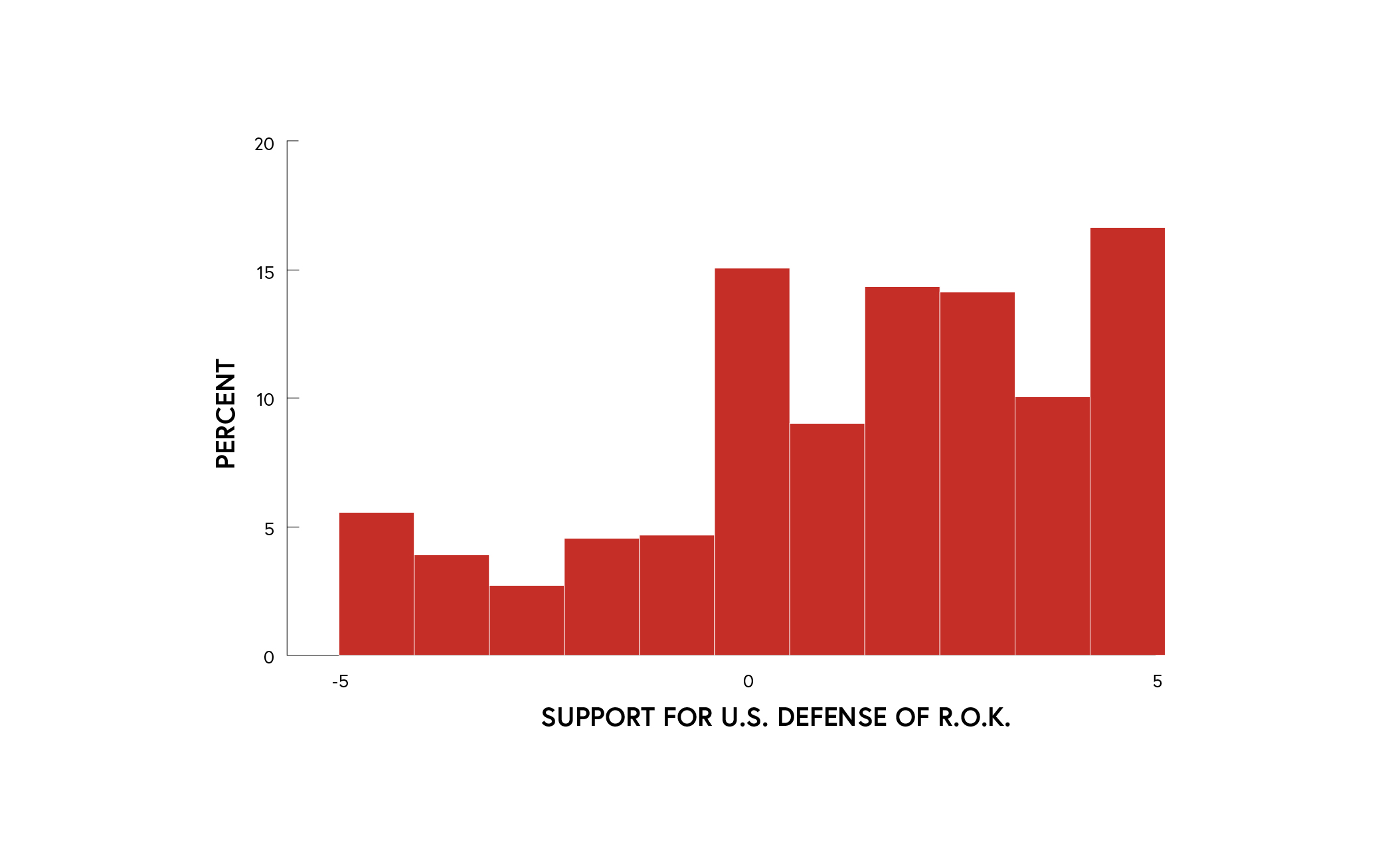
Figure 3: Mean Response by Treatment Group56
Leadership Condition
News Source Condition
We examine the effect of the LEADER condition by performing one tailed t-tests comparing mean responses across treatment groups for Democrats and Republicans separately.57 Democrat support of South Korea was 0.36 points higher if they received the Biden cue relative to the neutral control and 0.68 points higher relative to the Trump cue. Interestingly, the Trump cue significantly decreases support among Democrats, relative to the neutral control, by about 0.32 points. For Republicans, the Trump cue increases support by more than 1 point on the Likert scale relative to both the control and the Biden cue. However, the Biden cue does not affect Republicans differently from the control group. Therefore, we find that group identity has an effect on the views of both Democrats and Republicans, who are more likely to support South Korea when given a cue that aligns with their group identity. Among Democrats, we further find evidence of affective polarization: A Trump cue decreases support for South Korea below the baseline of a neutral expert about as much as a Biden cue raises support.
In contrast, the NEWS condition did not have a significant effect on Democrats or Republicans.58 This suggests that leader cues may be more effective in arousing partisan sentiment, especially in issues pertaining to alliances.
Our results differ from those of Kyung Suk Lee and Kirby Goidel, who found that, while framing an alliance in terms of cost reduces U.S. voter support for NATO, a Trump cue has a weaker and more mixed effect.59 We believe that our experiment has an important methodological advantage: We embed our experiment into a realistic news story that provides a quote attributed to the former president, whereas Lee and Goidel present a long text that describes Trump’s views in the third person. It is plausible that this difference in framing explains the diverging results. Another difference is that our experiment examines the effect of leadership cues in raising support for South Korea, since the quote expresses a positive view. Lee and Goidel instead present Trump’s negative views of NATO. The quote we chose to attribute to Trump is in many ways misaligned with the platform that the former president pushed forward during his campaign and time in office, so we presume that an alternative framing that presented a negative point of view toward South Korea would have equal or stronger effects in reducing Republican support for the alliance. However, we leave the validation of this hypothesis to future research.
Negative Language Experiment
Above, we saw that key information about the U.S.-South Korean alliance does not affect Democrats’ and Republicans’ views on whether to support South Korea. But does the language in which this information is presented make a difference? In this section and the subsequent section, we study the role of language in shaping support for alliances. Polarizing language is often encountered in the context of social media, so for these experiments, we chose to present the treatments in the form of tweets from a fabricated user. Given the mutually contradicting frameworks of the Negative Language and Positive Language Experiments, respondents were randomly assigned to one or the other, but never to both.
Table 3: Negative Language Experiment Treatment Conditions
| Conditions | Options |
| Ripping Off | 0: “relying excessively on U.S. support” 1: “ripping us off” |
| America First | 0: “carefully consider national interests” 1: “put America first” |
In the Negative Language Experiment, we were interested in understanding the differential effect of language that is critical of an ally on Republicans’ and Democrats’ overall support for South Korea. Toward this end, respondents were presented a tweet with the following structure:
Once again, South Korea is [Ripping Off Condition] by asking us to intervene in this conflict with China. It is time that we [America First Condition] and keep troops home! #hypersonicmissile
The text in the two condition blocks was randomly assigned from the options presented in Table 3. In both cases, the first option expresses a point of view using mild negative language and the second option expresses the same point of view using more emotionally charged language. The text was then formatted to look like tweets.60
By contrast, the effects of the negative language treatments for Republicans are quite large and statistically significant.
Both conditions reflect concerns raised by Trump during the 2016 election and his subsequent years in office. The Ripping Off Condition echoes a frequent claim Trump made that allies “rip us off.” The America First Condition emulates Trump’s campaign slogan “America First” that he used during the 2016 election campaign, and which later became a tagline for his foreign policy approach. In both cases, the second option utilizes the same language that Trump has used in the past.
Additionally, we included a control treatment with no tweet to provide a baseline reference. Respondents in the control group were presented the following information on the situation:
After news about the hypersonic missile tests was released, South Korea requested increased U.S. military support. The U.S. is currently considering whether to deploy more troops to South Korea.
Survey participants were randomly assigned one of these four treatment variations or the control. Afterward, participants were asked whether they disagreed or agreed with the following statement on a scale of -5 (strongly disagree) to 5 (strongly agree): “The U.S. should deploy troops to South Korea.”
Figure 4: Histogram of Responses to Negative and Positive Language Experiment
Democrats
Republicans
The distribution of responses to the question of whether the United States should deploy troops to South Korea is much more uniform than that of whether to defend South Korea in the Leader and Media Cue Experiment, especially for Republicans, a third of whom indicated that America should not deploy troops to South Korea. In contrast, about a quarter of Democrats opposed deploying troops.
In Figure 5, we show the effect of each treatment on Republicans’ and Democrats’ responses to the question of whether to deploy troops to South Korea across treatment groups. The first two bars indicate that the mean level of support for respondents in the control group (i.e., those who did not receive any tweet) is positive and relatively high for both Republicans and Democrats, although Republican support is slightly higher. The impact of the treatments vary widely, however, by political party. The negative language treatments have relatively small negative effects on Democrats, and neither the mildly negative nor the stronger negative cues are statistically significant. By contrast, the effects of the negative language treatments for Republicans are quite large and statistically significant. In fact, support among Republicans who saw any version of the tweet dropped sharply. Republicans who saw a tweet indicating that the United States should “carefully consider national interests” or that South Korea is “relying excessively on U.S. support” had mean scores about 1 point lower than those in the control group. Support for South Korea fell even further relative to the mild negative language cue for Republicans who received versions of the tweet that used stronger language associated with Trump. In particular, Republicans who saw the phrase “ripping us off” had a mean response 0.5 points lower than those who saw the more neutrally framed “relying excessively on U.S. support.” The inclusion of the term “America first” also lowered support for South Korea relative to those who saw the phrase “carefully consider national interests,” though in this case the difference is not statistically significant. The stronger versions that evoke Trump’s rhetoric also lowered support among Democrats relative to the mild negative cue. The differences are not statistically significant, however, perhaps due to the implicit Trump cue.
Thus, the mean level of support among Republicans who saw the stronger negative cues — “ripping us off” and “put America first” — dropped to below zero while among Democrats support remained positive across the board.61
Figure 5: Mean Support to Deploy Troops by Treatment Group
Positive Language Experiment
The Positive Language Experiment examines the effect of language that reinforces and upholds alliances. We chose to use a similar experiment format as in the Negative Language Experiment, but in this case, the tweets express support for deploying more troops to South Korea. The template for each tweet is as follows:
This move by China is [Values Condition]. We must [Duty Condition] and deploy troops to protect South Korea! #hypersonicmissile
The text for each condition is randomly assigned from options presented in Table 4. Again, the first option for each condition expresses a point of view using more neutral language, and the second option expresses the same point of view using emotionally charged language.
The conditions in this experiment reflect more traditional arguments in favor of U.S. involvement abroad, using the lofty language about duty and values that the Biden administration often utilizes. The Values Condition presents an ideological argument against China’s actions, using language about “American values.” The Duty Condition studies the effect of rhetoric regarding America’s international responsibilities — emphasizing the “duty” of the United States to the rest of the world — on the public’s willingness to support South Korea.
Table 4: Experiment 4 Treatment Conditions
| Conditions | Options |
| Values | 0: “concerning from an ethical standpoint” 1: “an outright challenge against American values” |
| Duty | 0: “take action” 1: “uphold our duty to our international partners” |
We used the same control group from the Negative Language Experiment and again randomly assigned the other respondents to one of the tweet variations. Participants were asked to rank whether they agreed or disagreed with the same statement presented in the Negative Language Experiment.
Both the VALUES and DUTY conditions had insignificant effects on both Democrats and Republicans, whose support for South Korea remained stable across all treatments.62 Therefore, it appears that appeals to traditional arguments in favor of alliances do not shift public opinion. Our results suggest that negative language that demeans alliances is more effective in changing public opinion than positive language which upholds alliances. One caveat, though, is that the positive cues, while more in line with rhetoric used by Biden, are less identifiable with a specific leader, compared to the more negative nationalist language used by Trump.
Conclusion
Collectively, our findings suggest that there are meaningful partisan differences in the level and resilience of support for a major U.S. ally, South Korea. Republicans have lower enthusiasm for aiding South Korea than Democrats, a finding that is consistent across different scenarios and controlling for different presentations of South Korea. This finding is particularly striking given that Republicans tend to be more willing in general to support the use of force, are more tolerant of casualties, and tend to view China as more threatening than Democrats. On average, however it should be noted that Republicans still support helping South Korea in all but one of our scenarios in our ideological polarization experiment.
Furthermore, our experiments investigating the effects of appeals to partisan group identity suggest that certain cues can shift support for an ally, in some cases sharply. A cue from a co-partisan leader (Biden or Trump) shifts voter views in the direction of the cue. The magnitude of the co-partisan leader effect is larger for Republicans who received the Trump leader cue than for Democrats who received the Biden cue. This finding is particularly notable since: 1) the message Republicans received in the treatment supportive of aiding South Korea was substantively the opposite of much of Trump’s actual anti-alliance rhetoric as a leader; and 2) Republicans express, on average, lower support than Democrats for defending and aiding South Korea as described above. We can speculate that a strong anti-alliance message would have at least as large of an effect on Republican voters. Indeed, we do find that negative language critical of allies reduces support for South Korea in a crisis situation both for Democrats and Republicans, although the effect is much larger and only statistically significant among Republicans. Positive language toward allies that appeals to duty and values, however, has no meaningful effect on Republicans or Democrats. Given that the strong negative cues are likely associated with messaging from the Trump administration, we cannot discount that the effect we are seeing reflects a shadow Trump cue, nor can we know yet if these expressions will prove durable and will resonate with Republican voters in the future. Nevertheless, even mild negative cues with no association with Trump have large effects. Lastly, we find some evidence of affective polarization, but only among Democrats. A Trump cue can push Democratic sentiment in the opposite direction, thereby increasing polarization. This was only observed in one of the experiments, but it is worth further investigation.
We show that partisan polarization can create greater uncertainty in voter support for defending an ally and troop deployments abroad.
Our study does have several limitations and caveats. First, we do not directly test if the increase in polarization in American society accounts for the partisan differences that we observe. Instead, we draw on the robust literature and polls discussed above that substantiate that both ideological and group-identity polarization have increased. We thus take polarization as a given. Given that our experiments were conducted at one point in time, we cannot test if these effects of partisanship are more pronounced than they were in the past or if they will intensify if polarization were to increase in the future.
Second, since we focus specifically on American voter views of South Korea, we cannot necessarily assume that our findings will apply to other alliances. Still, there are some reasons to be optimistic about the broader relevance of our work. South Korea shares strong common interests with the United States: Its adversaries — a nuclear-armed North Korea and China — are also widely seen as threats to America. Thus, if we see partisan differences in support for South Korea, we would expect to see even larger effects when it comes to allies with less convergent security interests. Furthermore, a 2022 article found that studies, like ours, that give participants specific details tend to produce similar results compared to designs that are more abstract (e.g., those that do not use specific countries or leader names). If anything, the effects in experiments with more detail tend to produce more conservative results compared to more abstract experimental designs.63
Despite these caveats, our results provide meaningful grounds for concern about how domestic politics might weaken U.S. alliance commitment. We show that partisan polarization can create greater uncertainty in voter support for defending an ally and troop deployments abroad. There are, however, many other ways that one can imagine how partisanship might weaken U.S. support for an ally. In the event of conflict, for instance, U.S. resolve to stay engaged would also likely be subject to partisan messaging and cues. Indeed, as current events in Ukraine show, even a small but dedicated minority could potentially block funding and threaten support for another country, using partisan slogans to justify their positions for withdrawing it.
These findings have policy implications for East Asia. The U.S.-South Korean alliance is one of the most significant alliances in East Asia. Strong public support in the United States for the alliance is necessary for maintaining a credible deterrent and reassuring allies in East Asia. With public support so subject to polarizing cues, adversaries may seek to exploit such divisions and attempt to sow doubt about the credibility of America’s security guarantee. Alarmed allies, dependent on the United States for their security, may seek to realign their foreign policies through various forms of hedging. Indeed, it is no coincidence that public support in South Korea for nuclear weapons increased and a growing number of experts began to call for the development of nuclear weapons during the Trump presidency.64
If there is a silver lining to our findings, it is that, in the absence of polarizing cues, Democrats and Republicans still support defending and aiding South Korea across a variety of crisis situations. To maintain support for the U.S.-South Korean alliance moving forward, our research shows that leader cues and messaging are paramount. Both can play a meaningful role in maintaining or undermining domestic support in the United States for allies such as South Korea.
Verónica Bäcker-Peral is a pre-doctoral researcher at Princeton University, studying macroeconomics and international finance.
Gene Park is a professor of political science and international relations and the director of the Global Policy Institute at Loyola Marymount University.
Acknowledgements: We would like to thank Gabriele Magni, Hsin-Hsin Pan, and the participants at a workshop held at Academia Sinica who provided comments.
This research was supported by the Korea Foundation.
Image: Executive Office of the President of the United States
Appendix A: Additional Figures and Tables
Table A.1: Ideological Polarization Scenarios
| North Korea Scenario | Mining Scenario |
| Tensions between South Korea and North Korea are high. North Korea fires artillery just across the border in an attempt to destroy loudspeakers in South Korea broadcasting news, music, and anti-North Korean messages into North Korea. South Korea then retaliates by returning fire. No one is harmed in the exchange. Then later in the year, North Korean naval ships fire on a South Korean naval vessel. The South Korean Navy returns fire, sinking a ship. Several weeks later, North Korea invades a South Korean island with a population of about 1,000 residents. In planning to retake the islands, the South Korean government confers with the U.S., to see if it will support South Korea. The U.S. government expects doing so would cause North Korea to retaliate, inflicting thousands of U.S. military casualties. Decision Point: Do you oppose or support the United States helping to retake the islands to aid South Korea? | South Korea starts mining cobalt, a valuable metal with many industrial uses, on the seabed of the East China Sea. The mining is in areas in which South Korea claims exclusive economic rights to seabed resources under international law. China, however, claims that it has exclusive rights. The dispute has never been settled under United Nation’s procedures. In the spring, Chinese naval vessels swarm South Korea’s mining operation and drive the South Koreans away, allowing the Chinese to control the area and mining operations. The South Korean government appeals to the United States for help to reclaim the area and its mining operation. China publicly states that any interference from the United States will be met with force, a threat that the U.S. military believes is credible and would result in thousands of U.S. military casualties. Decision Point: Do you oppose or support the U.S. government helping South Korea reclaim control over the maritime area? |
| Cyber Attack Scenario | Sea Patrol Scenario |
| The United States and South Korea sign a military cooperation agreement. Under the agreement, the United States will give South Korea new advanced missiles capable of avoiding missile defense systems, and South Korea will deploy these missiles on its land and naval vessels. The missiles are capable of striking not only North Korea but large population centers in China. China retaliates strongly against South Korea through a cyberattack, a targeted attack on the country’s computer networks that cripples its economy in an attempt to force South Korea to end its agreement with the United States. The U.S. government is considering a retaliatory cyberattack to pressure China to end its attack on South Korea. U.S. intelligence agencies estimate that there is a significant chance that China would respond against the United States in kind, causing billions of dollars in economic losses and possible shutdowns of critical infrastructure. Decision Point: Do you oppose or support the U.S. government conducting a cyberattack against China to pressure it to back off of South Korea? | The United States and South Korea have started joint sea patrols in the South China Sea, a body of water vital to international trade. China issues a statement that these joint patrols are a threat to its security and that it will not tolerate them. Several days later, the joint patrol enters territorial waters near an island that China controls but other countries also claim. Two days later, the Chinese military launches missiles that destroy a South Korean ship. The U.S. government considers sinking a Chinese vessel in return. China would likely escalate against the United States by targeting ships and military bases, resulting in thousands of U.S. military casualties. Decision Point: Do you oppose or support the U.S. government retaliating by sinking a Chinese ship? |
Table A.2: Ideological Polarization Experiment Treatment Effects: Scenario 1
| Democrat | Republican | |||||
| 1 | 2 | 3 | 4 | 5 | 6 | 7 |
| Ally | Cost | Common Interest | Ally | Cost | Common Interest | |
| Difference in Means | -0.276 (0.324) | -0.0750 (0.319) | -0.294 (0.324) | 0.116 (0.319) | 0.526 (0.323) | 0.0657 (0.319) |
| N | 305 | 320 | 305 | 320 | 305 | 320 |
∗ p < 0.1, ∗∗ p < 0.05, ∗∗∗ p < 0.01
The table reports two-tailed difference in mean t-tests for Scenario 1 of the Ideological Polarization experiment. Each column indicates the difference in mean between respondents that did or did not receive the ALLY, COST, and COMMON INTEREST treatments, respectively. The first three columns present t-tests for Democrats and the next three present t-tests for Republicans. In all cases, the results are insignificant.
b coefficients; se in parentheses
∗ p < 0.1, ∗∗ p < 0.05, ∗∗∗ p < 0.01
The table reports two-tailed difference in mean t-tests for Scenario 1 of the Ideological Polarization experiment. Each column indicates the difference in mean between respondents that did or did not receive the ALLY, COST, and COMMON INTEREST treatments, respectively. The first three columns present t-tests for Democrats and the next three present t-tests for Republicans. In all cases, the results are insignificant.
Table A.3: Ideological Polarization Experiment Treatment Effects: Scenario 2
| Democrat | Republican | |||||
| 1 | 2 | 3 | 4 | 5 | 6 | 7 |
| Ally | Cost | Common Interest | Ally | Cost | Common Interest | |
| Difference in Means | -0.0300 (0.328) | 0.487 (0.317) | -0.161 (0.329) | -0.534∗ (0.317) | 0.577∗ (0.327) | 0.0657 (0.319) |
| N | 305 | 320 | 305 | 320 | 305 | 320 |
∗ p < 0.1, ∗∗ p < 0.05, ∗∗∗ p < 0.01
The table reports two-tailed difference in mean t-tests for Scenario 2 of the Ideological Polarization experiment. Each column indicates the difference in mean between respondents that did or did not receive the ALLY, COST, and COMMON INTEREST treatments, respectively. The first three rows present t-tests for Democrats and the next three present t-tests for Republicans. In almost cases, the results are insignificant or weakly significant in the case of the COST and ALLY treatment on Republicans.
b coefficients; se in parentheses
∗ p < 0.1, ∗∗ p < 0.05, ∗∗∗ p < 0.01
The table reports two-tailed difference in mean t-tests for Scenario 2 of the Ideological Polarization experiment. Each column indicates the difference in mean between respondents that did or did not receive the ALLY, COST, and COMMON INTEREST treatments, respectively. The first three columns present t-tests for Democrats and the next three present t-tests for Republicans. In almost cases, the results are insignificant or weakly significant in the case of the COST and ALLY treatment on Republicans.
Table A.4: Ideological Polarization Experiment Treatment Effects: Scenario 3
| Democrat | Republican | |||||
| 1 | 2 | 3 | 4 | 5 | 6 | 7 |
| Ally | Cost | Common Interest | Ally | Cost | Common Interest | |
| Difference in Means | -0.301 (0.345) | 0.294 (0.331) | -0.0111 (0.346) | -0.400 (0.331) | 0.294 (0.346) | 0.588∗ (0.330) |
| N | 305 | 320 | 305 | 320 | 305 | 320 |
∗ p < 0.1, ∗∗ p < 0.05, ∗∗∗ p < 0.01
The table reports two-tailed difference in mean t-tests for Scenario 3 of the Ideological Polarization experiment. Each column indicates the difference in mean between respondents that did or did not receive the ALLY, COST, and COMMON INTEREST treatments, respectively. The first three rows present t-tests for Democrats and the next three present t-tests for Republicans. In almost cases, the results are insignificant or weakly significant in the case of the COMMON INTEREST treatment on Republicans.
b coefficients; se in parentheses
∗ p < 0.1, ∗∗ p < 0.05, ∗∗∗ p < 0.01
The table reports two-tailed difference in mean t-tests for Scenario 3 of the Ideological Polarization experiment. Each column indicates the difference in mean between respondents that did or did not receive the ALLY, COST, and COMMON INTEREST treatments, respectively. The first three columns present t-tests for Democrats and the next three present t-tests for Republicans. In almost cases, the results are insignificant or weakly significant in the case of the COMMON INTEREST treatment on Republicans.
Table A.5: Ideological Polarization Experiment Treatment Effects: Scenario 4
| Democrat | Republican | |||||
| 1 | 2 | 3 | 4 | 5 | 6 | 7 |
| Ally | Cost | Common Interest | Ally | Cost | Common Interest | |
| Difference in Means | -0.517 (0.347) | 0.506 (0.352) | -0.168 (0.348) | 0.0182 (0.353) | 0.128 (0.348) | 0.118 (0.352) |
| N | 305 | 320 | 305 | 320 | 305 | 320 |
∗ p < 0.1, ∗∗ p < 0.05, ∗∗∗ p < 0.01
The table reports two-tailed difference in mean t-tests for Scenario 4 of the Ideological Polarization experiment. Each column indicates the difference in mean between respondents that did or did not receive the ALLY, COST, and COMMON INTEREST treatments, respectively. The first three rows present t-tests for Democrats and the next three present t-tests for Republicans. In most cases, the results are insignificant.
b coefficients; se in parentheses
∗ p < 0.1, ∗∗ p < 0.05, ∗∗∗ p < 0.01
The table reports two-tailed difference in mean t-tests for Scenario 4 of the Ideological Polarization experiment. Each column indicates the difference in mean between respondents that did or did not receive the ALLY, COST, and COMMON INTEREST treatments, respectively. The first three columns present t-tests for Democrats and the next three present t-tests for Republicans. In most cases, the results are insignificant.
Table A.6: Leader Cue T-Tests
| Cue | ||||||||
| Reference | Neutral | Trump | Neutral | Biden | Neutral | Trump | Neutral | Biden |
| 1 | 2 | 3 | 4 | 5 | 6 | 7 | 8 | |
| Difference in Means | 0.355∗∗ (0.204) | 0.678∗∗∗ (0.216) | -0.323∗ (0.211) | -0.678∗∗∗ (0.216) | 0.019 (0.232) | -1.108∗∗∗ (0.209) | 1.127∗∗∗ (0.218) | 1.108∗∗∗ (0.209) |
| Ha | Diff > 0 | Diff > 0 | Diff < 0 | Diff < 0 | Diff < 0 | Diff < 0 | Diff > 0 | Diff > 0 |
| Rejects Ho | ✓ | ✓ | ✓ | ✓ | ✓ | ✓ | ✓ | |
| N | 590 | 594 | 626 | 594 | 654 | 694 | 634 | 694 |
∗ p < 0.10, ∗∗ p < 0.05, ∗∗∗ p < 0.01
The table reports one-tailed t-test results. Each column reports the difference in mean response between respondents who saw the cue (listed in the second row) and respondents who saw the corresponding reference (listed in the third row). For each row, the alternative hypothesis that respondents will align with the corresponding co-partisan leader is indicated. The table also indicates that the null hypothesis is rejected in all cases except for Column 5.
Standard errors in parentheses
∗ p < 0.10, ∗∗ p < 0.05, ∗∗∗ p < 0.01
The table reports one-tailed t-test results. Each column reports the difference in mean response between respondents who saw the cue (listed in the second row) and respondents who saw the corresponding reference (listed in the third row). For each row, the alternative hypothesis that respondents will align with the corresponding co-partisan leader is indicated. The table also indicates that the null hypothesis is rejected in all cases except for Column 5.
Table A.7: News Source Cue T-Tests
| Cue | ||||||||
| Reference | AP | FOX | AP | CNN | AP | FOX | AP | CNN |
| 1 | 2 | 3 | 4 | 5 | 6 | 7 | 8 | |
| Difference in Means | 0.220 (0.213) | 0.339∗ (0.208) | -0.119 (0.212) | -0.339∗ (0.208) | -0.312∗ (0.224) | 0.004 (0.227) | -0.316 (0.217) | -0.004 (0.227) |
| Ha | Diff > 0 | Diff > 0 | Diff < 0 | Diff < 0 | Diff < 0 | Diff < 0 | Diff > 0 | Diff > 0 |
| N | 591 | 629 | 590 | 629 | 656 | 669 | 657 | 669 |
∗ p < 0.10, ∗∗ p < 0.05, ∗∗∗ p < 0.01
The table reports one-tailed t-test results. Each column reports the difference in mean response between respondents who saw the cue (listed in the second row) and respondents who saw the corresponding reference (listed in the third row).
Standard errors in parentheses
∗ p < 0.10, ∗∗ p < 0.05, ∗∗∗ p < 0.01
The table reports one-tailed t-test results. Each column reports the difference in mean response between respondents who saw the cue (listed in the second row) and respondents who saw the corresponding reference (listed in the third row).
Table A.8: Negative Language T-Tests
| America First | Rip Off | America First | Rip Off | |
| 1 | 2 | 3 | 4 | |
| Difference In Means | -0.311 (0.243) | -0.251 (0.241) | -0.471∗∗ (0.260) | -0.677∗∗∗ (0.258) |
| Ha | Diff < 0 | Diff < 0 | Diff < 0 | Diff < 0 |
| Rejects Ho | ✓ | ✓ | ||
| N | 507 | 507 | 563 | 563 |
Standard errors in parentheses
∗ p < 0.10, ∗∗ p < 0.05, ∗∗∗ p < 0.01
The table reports one-tailed t-test results. Each column reports the difference in mean response between respondents who received the AMERICA FIRST and RIP OFF treatments and those who did not. Results are presented separately for Democrats and Republicans. In each column, the alternative hypothesis (Ha) is that the difference in means is negative, meaning that the more negative version of the condition ought to decrease support for South Korea. The alternative hypothesis is rejected for Columns (3) and (4), for Republican respondents.
Table A.9: Positive Language T-Tests
| Values | Duty | Values | Duty | |
| 1 | 2 | 3 | 4 | |
| Difference In Means | 0.101 (0.248) | 0.072 (0.247) | -0.108 (0.255) | -0.056 (0.254) |
| Ha | Diff > 0 | Diff > 0 | Diff > 0 | Diff > 0 |
| Rejects Ho | ||||
| N | 507 | 507 | 550 | 550 |
∗ p < 0.10, ∗∗ p < 0.05, ∗∗∗ p < 0.01
The table reports one-tailed t-test results. Each column reports the difference in mean response between respondents who received the VALUES and DUTY treatments and those who did not. Results are presented separately for Democrats and Republicans.
Standard errors in parentheses
∗ p < 0.10, ∗∗ p < 0.05, ∗∗∗ p < 0.01
The table reports one-tailed t-test results. Each column reports the difference in mean response between respondents who received the VALUES and DUTY treatments and those who did not. Results are presented separately for Democrats and Republicans.
Figure A.1: Mean Support To Deploy Troops By Treatment Group (Positive Language)
The figure presents the mean response to the question of whether to deploy troops to South Korea across treatment groups of the Positive Language Experiment for Democrats and Republicans. The first two bars include respondents who saw the control tweet. The remaining bars present the mean response across all respondents who saw the indicated variation of the VALUES and DUTY conditions. 95 percent confidence intervals are shown.
Table A.10: Leader and Media Experiment Treatment Variations
| CNN Presented as an article from CNN | Fox News Presented as an article from Fox News | AP Presented as an article from the AP |
|
| Biden Presented alongside an image of Biden | Biden claims that US must protect South Korea from nuclear threat After back-to-back hypersonic ballistic missile tests from China and North Korea, experts are concerned about the danger this poses to South Korea. "I will do everything in my power to defend our South Korean allies," said President Biden at a press conference today, "we can not tolerate any Chinese or North Korean threat against the core American values of liberty and democracy." | Biden claims that US must protect South Korea from nuclear threat After back-to-back hypersonic ballistic missile tests from China and North Korea, experts are concerned about the danger this poses to South Korea. "I will do everything in my power to defend our South Korean allies," said President Biden at a press conference today, "we can not tolerate any Chinese or North Korean threat against the core American values of liberty and democracy." | Biden claims that US must protect South Korea from nuclear threat After back-to-back hypersonic ballistic missile tests from China and North Korea, experts are concerned about the danger this poses to South Korea. "I will do everything in my power to defend our South Korean allies," said President Biden at a press conference today, "we can not tolerate any Chinese or North Korean threat against the core American values of liberty and democracy." |
| Trump Presented alongside an image of Trump | Trump claims that US must protect South Korea from nuclear threat After back-to-back hypersonic ballistic missile tests from China and North Korea, experts are concerned about the danger this poses to South Korea. "I will do everything in my power to defend our South Korean allies," said former President Trump at a press conference today, "we can not tolerate any Chinese or North Korean threat against the core American values of liberty and democracy." | Trump claims that US must protect South Korea from nuclear threat After back-to-back hypersonic ballistic missile tests from China and North Korea, experts are concerned about the danger this poses to South Korea. "I will do everything in my power to defend our South Korean allies," said former President Trump at a press conference today, "we can not tolerate any Chinese or North Korean threat against the core American values of liberty and democracy." | Trump claims that US must protect South Korea from nuclear threat After back-to-back hypersonic ballistic missile tests from China and North Korea, experts are concerned about the danger this poses to South Korea. "I will do everything in my power to defend our South Korean allies," said former President Trump at a press conference today, "we can not tolerate any Chinese or North Korean threat against the core American values of liberty and democracy." |
| Neutral Presented alongside an image of an expert | Expert claims that US must protect South Korea from nuclear threat After back-to-back hypersonic ballistic missile tests from China and North Korea, experts are concerned about the danger this poses to South Korea. "I will do everything in my power to defend our South Korean allies," said foreign policy expert Tim Anderson at a press conference today, "we can not tolerate any Chinese or North Korean threat against the core American values of liberty and democracy." | Expert claims that US must protect South Korea from nuclear threat After back-to-back hypersonic ballistic missile tests from China and North Korea, experts are concerned about the danger this poses to South Korea. "I will do everything in my power to defend our South Korean allies," said foreign policy expert Tim Anderson at a press conference today, "we can not tolerate any Chinese or North Korean threat against the core American values of liberty and democracy." | Expert claims that US must protect South Korea from nuclear threat After back-to-back hypersonic ballistic missile tests from China and North Korea, experts are concerned about the danger this poses to South Korea. "I will do everything in my power to defend our South Korean allies," said foreign policy expert Tim Anderson at a press conference today, "we can not tolerate any Chinese or North Korean threat against the core American values of liberty and democracy." |
Figure A.2: Example Tweet
Appendix B: Demographic Distribution
In Figures B.1 and B.2. we present the distribution of ethnicity, age, and region of our respondents, which were provided by the company that fielded our survey. The distribution of respondents is selected such that it is roughly representative of the United States as a whole.
Figure B.1: Ideological Polarization Survey Demographic Distribution
(a) Race
(b) Age
(c) Region
Figure B.2: Group Polarization Survey Demographic Distribution
(a) Race
(b) Age
(c) Region
Appendix C: Robustness Checks
Alternative Measures of Partisanship
In our paper, we classify respondents as Democrats and Republicans based on how they self-identify. Our results are robust to classifying individuals based on whether they voted for Trump or Biden in 2020.65 In Figures C.4, C.5, and C.6, we see that our main results from all the experiments hold whether we split by reported partisan identification or by reported 2020 vote.
Figure C.1: Mean Response to Ideological Polarization Experiment, By Partisanship and 2020 Vote
The figure presents the mean response to each scenario of the Ideological Polarization Experiment for Democrats and Republicans, as well as for Trump and Biden voters (using their reported vote from the 2020 election). The sample excludes the small percent of respondents who voted for third parties. 95 percent confidence intervals are shown.
Figure C.2: Mean Response to Leader and Media Cue Experiment, By Partisanship and 2020 Vote
The figure presents the mean response to the Leader and Media Cue value question for Democrats and Republicans, as well as for Trump and Biden voters (using reported vote from the 2020 election). The sample is further divided according to which leader cue respondents received. The sample excludes the small percent of respondents who voted for third parties. 95 percent confidence intervals are shown.
Figure C.3: Mean Response to Negative Language Experiment, By Partisanship and 2020 Vote
The figure presents the mean response to the question of whether to deploy troops to South Korea for Democrats and Republicans, as well as for Trump and Biden voters (using their reported vote from the 2020 election). The sample is further divided according to which version of the America First and Rip Off conditions the respondent received. The sample excludes the small percent of respondents who voted for third parties. 95 percent confidence intervals are shown.
Spillovers Between Experiments
The Leadership and Media Source Experiment as well as both Language Experiments were fielded on the same survey and their order was randomized. Because of this randomization, any bias that one experiment has on the other will have mean zero and therefore are highly unlikely to explain our results. However, to mitigate any concerns, we present our results for the Leadership and Media Source Cues Experiment, Negative Language Experiment, and Positive Language Experiment using only the respondents who saw that experiment first, and therefore cannot have been biased by spillovers. The results for the Leadership and Media Source Cues Experiment and the Positive Language Experiment are statistically unchanged, as seen in Table C.1, Table C.2, and Table C.3. The results for the Negative Language Experiment are similar in magnitude, as seen in Table C.4. However, the America First treatment is no longer statistically significant likely due to the loss of observations.
Table C.1: Leader Cue T-Tests, Robustness Check
| Cue | ||||||||
| Reference | Neutral | Trump | Neutral | Biden | Neutral | Trump | Neutral | Biden |
| 1 | 2 | 3 | 4 | 5 | 6 | 7 | 8 | |
| Difference in Means | 0.440∗ (0.282) | 0.819∗∗∗ (0.306) | -0.379∗ (0.297) | -0.819∗∗∗ (0.306) | -0.195 (0.325) | -1.3∗∗∗ (0.296) | 1.1∗∗∗ (0.310) | 1.3∗∗∗ (0.296) |
| N | 286 | 297 | 323 | 297 | 336 | 351 | 321 | 351 |
∗ p < 0.10, ∗∗ p < 0.05, ∗∗∗ p < 0.01
The table reports one-tailed t-test results for the Leader and News Cues experiment across each leader cue. The sample is restricted to respondents who received the Leader and News Cue experiment before receiving the Positive/Negative Language experiment.
Standard errors in parentheses
∗ p < 0.10, ∗∗ p < 0.05, ∗∗∗ p < 0.01
The table reports one-tailed t-test results for the Leader and News Cues experiment across each leader cue. The sample is restricted to respondents who received the Leader and News Cue experiment before receiving the Positive/Negative Language experiment.
Table C.2: News Source Cue T-Tests, Robustness Check
| Cue | ||||||||
| Reference | AP | FOX | AP | CNN | AP | FOX | AP | CNN |
| 1 | 2 | 3 | 4 | 5 | 6 | 7 | 8 | |
| Difference in Means | -0.071 (0.297) | 0.287 (0.303) | -0.358 (0.290) | -0.287 (0.303) | -0.26 (0.319) | 0.157 (0.316) | -0.417∗ (0.312) | -0.157 (0.316) |
| N | 290 | 318 | 298 | 318 | 333 | 348 | 327 | 348 |
∗ p < 0.10, ∗∗ p < 0.05, ∗∗∗ p < 0.01
The table reports one-tailed t-test results for the Leader and News Cues experiment across each news cue. The sample is restricted to respondents who received the Leader and News Cue experiment before receiving the Positive/Negative Language experiment.
Standard errors in parentheses
∗ p < 0.10, ∗∗ p < 0.05, ∗∗∗ p < 0.01
The table reports one-tailed t-test results for the Leader and News Cues experiment across each news cue. The sample is restricted to respondents who received the Leader and News Cue experiment before receiving the Positive/Negative Language experiment.
Table C.3: Negative Language T-Tests, Robustness Check
| America First | Rip Off | America First | Rip Off | |
| 1 | 2 | 3 | 4 | |
| Difference In Means | -0.083 (0.345) | -0.365 (0.347) | -0.416 (0.373) | -0.592∗ (0.366) |
| N | 251 | 251 | 268 | 268 |
Standard errors in parentheses
∗ p < 0.10, ∗∗ p < 0.05, ∗∗∗ p < 0.01
The table reports one-tailed t-test results for the Negative Language experiment. The sample is restricted to respondents who received the Negative Language experiment before receiving the Leader and News Cue.
Table C.4: Positive Language T-Tests, Robustness Check
| Values | Duty | Values | Duty | |
| 1 | 2 | 3 | 4 | |
| Difference In Means | -0.139 (0.366) | -0.031 (0.365) | 0.255 (0.343) | 0.004 (0.332) |
| N | 254 | 254 | 279 | 279 |
Standard errors in parentheses
∗ p < 0.10, ∗∗ p < 0.05, ∗∗∗ p < 0.01
The table reports one-tailed t-test results for the Positive Language experiment. The sample is restricted to respondents who received the Positive Language experiment before receiving the Leader and News Cue.
